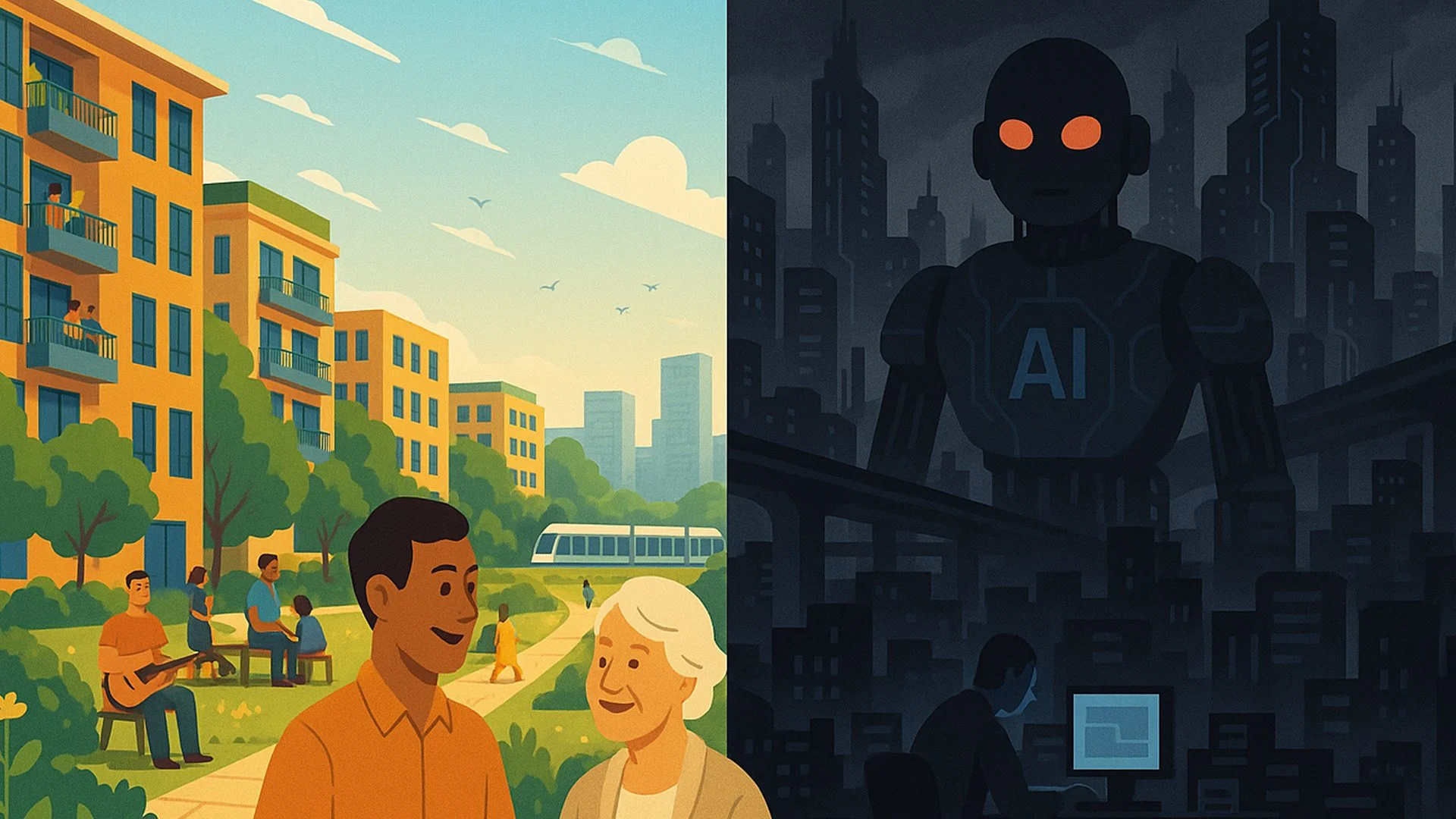It's 2045, and We Didn't Lose Control of AI: A Fictitious yet Plausible Look at a Future Where We Stayed in the Driver's Seat 💪
Lately it feels like we're building the wrong AI future. A different future is still possible. What if AI helped us become more human? This is a vision of the future we could create by choosing progress with purpose. Where AI didn’t replace what makes us human – it protected it. A future that turned out better – not by accident, but by design.
In this reimagined world 20 years in the future, we didn’t let AI hollow out our lives. We didn’t allow it to erode creativity, critical thinking, or the kinds of work that actually give people a reason to get out of bed in the morning.
Instead, we redirected it. We gave AI the kinds of tasks that tend to drain our time, energy, and ability to self-actualise. Life admin. Scheduling. Spreadsheets. The background noise of modern life – essential, but rarely fulfilling.
At the same time, AI began to enhance the systems and sectors that make life better: healthcare, education, infrastructure, governance. Not replacing people – but supporting them.
What followed wasn’t a techno-utopia. Just a better version of the world. One where people had more time for the things that make life worth living – time with family, with friends, with community. And, finally, with themselves.
The Tipping Point
For a while, it felt like technology was spiraling out of our control. Not in the dramatic, robot-uprising kind of way – but something quieter, more insidious. We let AI creep into parts of life we didn’t realise we’d miss until they were gone.
First, it took the mundane stuff: sorting files, booking meetings, managing spreadsheets. But then it reached further. It started doing the creative work, the research, the problem-solving, the deep analysis, the storytelling, and the programming. While the headcount dwindled, the jobs that remained became hollowed out, until the people inside them no longer felt like they mattered.
Musicians became obsolete in the face of infinite algorithmic mimicry. Designers found themselves closer to consultants than doers, signing off on work made by machines. Writers were reduced to editing the output of LLMs trained on centuries of culture they had no hand in creating.
At the same time, our decision-making was slowly outsourced to predictive systems. What to eat, where to go, who to date, what to believe – all subtly nudged by invisible recommendation engines optimised for engagement, not well-being. It was convenient, yes. But also disorienting. Like we’d traded agency for automation and weren’t sure how to get it back.
Then something shifted. Not all at once, but collectively – across communities, industries, governments. It began with discomfort, then frustration, then resolution. We didn’t want to destroy the systems. We wanted to reclaim them.
So we started to ask better questions. Not “How powerful can this be?” but “What is it for?” And the answers reshaped everything.
Redefining AI’s Role
These faceless software and hardware systems didn’t go away. They just stopped trying to be us.
Instead, they took on the roles we were glad to leave behind. On a personal level, AI quietly and competently manages the hum of daily life. Chores, emails, shopping – all delegated to systems that don’t forget, complain, or give up halfway through.
On a societal level, alongside a few brilliant humans, AI now manages distribution systems, transportation, waste management, planning permissions, and tax reviews – not with ruthless efficiency, but with a sense of care, context, and adaptability we designed into the system. These are the tasks no one misses – the vital but thankless parts of keeping a society running.
Tech with a Heart
More importantly, the sectors that matter most – education, healthcare, aged care – are no longer underfunded or overstretched. AI doesn’t replace teaching and caring. It works away in the background handling the data, the monitoring, the admin, the logistics. This frees up the people in these roles to focus on what really matters: listening, teaching, healing, connecting.
In politics, things changed too. With better modelling, forecasting, and unbiased analysis, policy-making is no longer just a game of influence and spin. Citizens are more engaged, because the process is more transparent. Power is more distributed. Assemblies debate. AI presents options and forecasts. But people still choose – not by instinct, but with insight.
The New Economy of Enough
As automation replaced more and more traditional employment, we responded with a shift that had once seemed radical and now feels obvious: universal basic income. Not enormous, but enough. A floor, not a ceiling.
It created space for people to choose how they contribute – not just to economies, but to communities. Work didn’t vanish. It changed. Most people do paid work part-time. Some work seasonally. Many volunteer.
With less pressure to hustle, people began doing the things they’d always said they wanted to do – learn a new skill, join a community, or start a business. Economic productivity charts levelled a little, but happiness soared.
Neighbourhoods Made for Living
New neighbourhoods emerged to match the new rhythm of life – designed from scratch on the outskirts of cities in organic layered rings. But change wasn’t limited to the new. Existing cities, too, began to shift. Car-choked streets gave way to walkability. Parking lots became parks. Empty office buildings were transformed into housing and hubs for community services. Even the most stubborn concrete gave way to something softer and smarter.
At the heart of these new neighbourhoods lies a vibrant core: learning hubs, maker studios, co-working spaces, and public squares. Knowledge flows freely. Equipment is often rented or shared, not bought. Generations mix easily – a curious teen learning woodwork from a retiree, a young technologist helping an elder digitise their record archives and accepting a few for their own collection.
Radiating outward are mid-rise, vertical communities with shared rooftop gardens, kitchens, libraries, and lounges. These aren’t just apartment blocks – they’re social ecosystems. Neighbours teach each other to cook or jump in when someone needs an AI assistant whipped up to ease a task. The line between public and private softens.
Further out, leafy streets and parks connect clusters of family homes, dotted with schools, pubs, and play spaces. These zones are calm and communal – close enough to feel connected, spaced enough to breathe.
And surrounding it all is the green ring – a living boundary of smart farmland, forests, sports fields, and protected wildlife zones. It nourishes people and planet, offering food, shade, and space to roam. With weekends no longer really a thing, these areas are alive most days – club activities, quiet walks, afternoon picnics, moments to reflect.
Threaded together by light rail, walking trails, and bike paths, nothing feels far. Cars are rare. Noise is low. Movement feels easy – a nervous system built to connect, not congest.
Policy, Not Magic
Nobody snapped their fingers and created a revolution. It took policy. Regulation. Citizen movements. A shared refusal to accept that “inevitable” meant “desirable.” We stopped trying to make humans work around machines and instead made machines better suited to human lives.
We didn’t build a utopia. We still argue. Still mess up. But the systems now allow for error, learning, and course correction. There’s space to reflect, to rebuild, to exhale. There are still individuals hoping to tear it all down. But transparency and information always save the day. Because when people have the time and energy to sit back and think, the noise washes over them.
The New Normal
And so, on a Wednesday evening, in a sun-warmed rooftop communal kitchen, someone is making soup. Neighbours arrive one by one, bringing bread and wine. They sit, they talk, they share updates about the local repair hub, the citywide vote on a new green space, the festival next weekend.
Someone starts playing music. A scientist lends a book to a curious teenager. Somewhere in a data centre far away AI prepares the relevant systems for tomorrow’s heatwave. No one had to log an entry or flip a switch.
In this new normal, we didn’t just survive the age of AI. We shaped it. The machines are doing their job. And for the first time in a long while – so are we.

